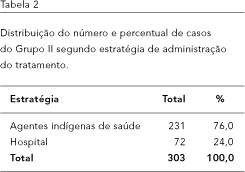In January 1998, home treatment regimens were launched in the municipality of Dourados, State of Mato Grosso do Sul, Brazil, and accompanied by indigenous health agents as a means of replacing the previous regimen, in which Guaraní-Kaiwá tuberculosis patients were systematically hospitalized for up to six months in the Porta da Esperança Hospital. In order to verify whether this change in strategy had any effect on the cure and treatment dropout rates,, a retrospective study was conducted on 594 patient records from January 1996 to December 1999. Patients were divided into two groups: Group I, treated by hospitalization (291 cases) and Group II, treated as outpatients (303 cases). Group II patients showed a significant increase in the cure rate and a significant reduction in the treatment dropout rate. The study also showed a high tuberculosis prevalence rate in children (40%), subsequently reported to the competent health authorities and thus launching specific projects to deal with this epidemiological reality. Based on these results, it is recommended that the assisted treatment strategy be adopted for other Indian populations.
Tuberculosis; South American Indians; Residential Treatment




